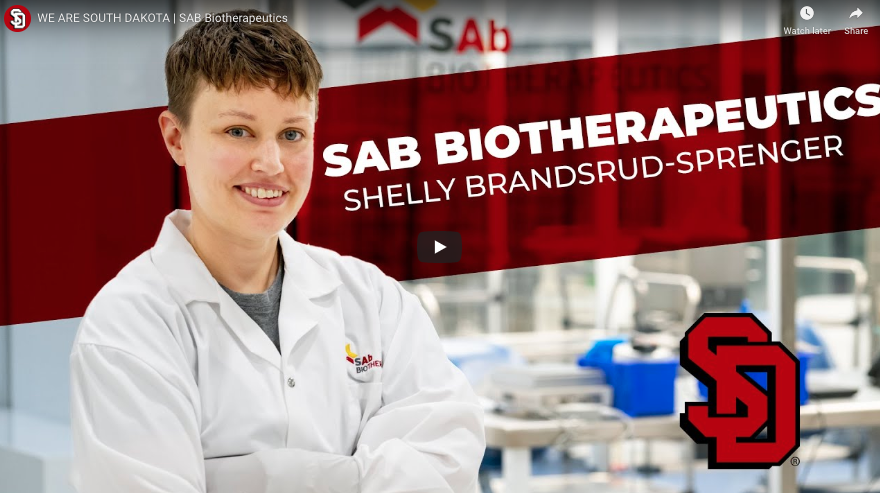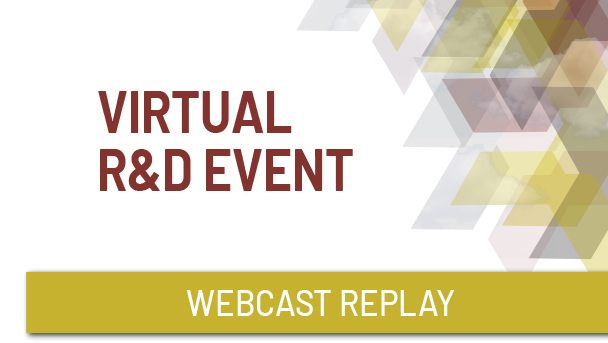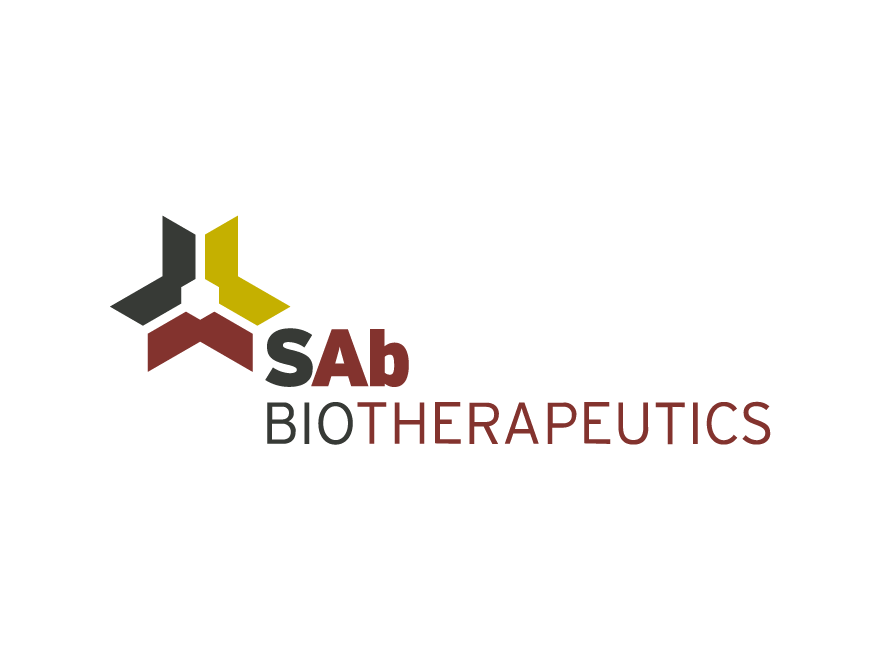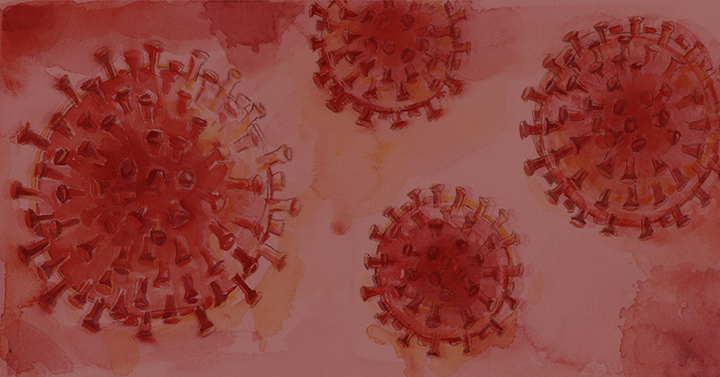December 13, 2019
By Michelle Cwach ‘09
A year after Shelly Brandsrud-Sprenger (’08, biology) gave birth to her first son, she was confronted with the most terrifying news of her life: She had breast cancer.
As a new mother, Sprenger faced relatable fears: fear of the unknown, fear of missing out, fear of death. But as a leading researcher in the field of immunology and genetic engineering, she knew she also had tremendous reason for hope.
Sprenger, manager of the molecular genetics and immunology department at SAB Biotherapeutics, a South Dakota clinical-stage biopharmaceutical development company, was diagnosed with a very large tumor that was triple positive, meaning it was hormone- and HER2-positive. That was a mixture of good and bad news, as the cancer was aggressive but likely to respond to hormone therapy.
“It was difficult telling my coworkers. I had been at SAB Biotherapeutics for a decade, and we’re like family,” she said. “At the same time, it was easiest telling my fellow scientists about my diagnosis, because we know that these diseases are treatable. We also know that our system of next-generation therapies will do a much better job of treating these diseases.”
“Looking back even 12 years ago, if I had been diagnosed and if companies such as SAB Biotherapeutics hadn’t developed immunotherapies, I would have had a few years to live. Now, the world is a different place thanks to these immunotherapies,” she said. “Before, there would have been no hope. Now, we have hope.”
A NATURAL SOLUTION
Sprenger, a Watertown native, who graduated from the University of South Dakota in 2008, started her career at SAB Biotherapeutics 11 years ago, before the company (formerly Hematech) had formalized to commercialize its groundbreaking technology. The company was founded to discover the complex answer to a very simple question: What if we could create new medicines to fight disease the same way our bodies do?
At its core, SAB Biotherapeutics is “really leveraging the natural way that our bodies fight disease,” according to Eddie Sullivan, president, co-founder and CEO of SAB Biotherapeutics.
The project first began in 1998 at the University of Massachusetts Amherst with the idea of developing immunotherapies – or human antibodies – in a large animal species, and targeting those to specific diseases like infectious diseases, cancers and autoimmune diseases.
“When our bodies are attacked by a virus, bacteria or even a cancer cell; our bodies will respond to it by producing these very special proteins called antibodies and that works with our immune system to essentially cure the disease,” Sullivan said. “We get sick simply because our bodies become overwhelmed. What we’re doing is just having these animals produce more of those antibodies, and then we’re essentially supplementing the unique response that humans are already having to the diseases that we’re fighting.”
Naturally, human bodies produce polyclonal antibodies against an invader. These antibodies, or immunoglobulins, are proteins produced by the immune system to help stop invaders from harming the body.
To explain it in the simplest terms, Sullivan says he often compares it to a battlefield.
“If you think about it, the way our bodies fight disease is not just by having just a single soldier, right? You can imagine that when our bodies are fighting disease, there’s a war going on. Our bodies are trying to fight a disease invader or something that’s wrong inside of our bodies, and so we often think of it as this battle that’s going on,” he explained. “What we’re doing is providing more soldiers – but not just soldiers, but Marines and Navy and Air Force, Army, the whole spectrum – to fight a battle that’s going on inside of the patient’s body.”
Monoclonal antibodies – the one-soldier approach Sullivan describes – are highly targeted, but not effective against mutants and are only effective for a limited number of diseases. Polyclonal antibodies, on the other hand, are naturally diverse, effective against mutants and successful for fighting many diseases. This is necessary for current and emerging diseases that are rapidly mutating, and involve activation of the entire immune system, Sullivan said.
Sullivan also noted the immunotherapies can be deployed against some of the most severe diseases the world has ever known. These diseases range from the rarer forms, like Ebola and Middle East Respiratory Syndrome (MERS), to the more common – but just as deadly – influenza.
“Influenza is actually one of the most severe diseases in the entire world,” Sullivan said. “Just in the United States alone, somewhere between 30,000 and 50,000 people a year die from influenza. In 2013, the third most common cause of death in the U.S. was influenza. It’s a highly mutating disease, and we’re developing products that we believe are going to solve a problem that has been the bane of human existence for many, many generations.”
“We’re making tremendous progress on treating really frightening diseases such as MERS, Ebola and the flu,” Sprenger added. “We have the potential to eliminate those diseases from the human condition. Not just minimize, but eliminate them. It’s very exciting, and it gives me a tremendous amount of hope that my son’s generation may not be impacted as heavily as my generation.”
SOPHISTICATED SCIENCE AND THE GENIUS OF NATURE
The first step in creating SAB’s platform technology was developing genetically designed cattle and essentially “turning-off” the genes that produce bovine antibodies. That was the biggest challenge and took nearly nine years, Sullivan said.
“That required a tremendous amount of work,” Sullivan said. “The human antibody genes, which are very large, were then transferred in what’s called the human artificial chromosome, and that was really the technology that we developed in order to be able to transfer those human antibody genes into the animals.”
From there, the cattle are injected with an antigen to generate an immune response, and the human polyclonal antibodies are collected in the cow’s plasma. Human antibodies are then isolated through a purification process, after which a custom, high-potency immunotherapy is produced.
Cows were selected as the host animal primarily because of their size and naturally robust immune systems, Sullivan said.
“We wanted the large animal species where you’d be able to get large amounts of antibodies,” Sullivan said. “As a result of using cows, our technology is highly scalable. For example, the entire worldwide need for our influenza product could be produced in about 60 to 80 animals. In South Dakota, that’s a small backyard herd.”
“And because cows are ruminants and have a very large bacteria vat as part of their digestive systems, their immune systems are extremely robust. They actually respond to vaccines or diseases much better than even humans do.”
While SAB’s innovative use of advanced genetic engineering is unique, animal-derived serum therapies are nothing new. In fact, they were first developed in 1890, and in 1901 the first Nobel Prize in medicine was given for the first therapeutic serum against diphtheria.
“In 1891, a researcher named Emil von Behring had the idea that if you took horses that had been exposed to diphtheria and you transferred the serum from those horses into people that had diphtheria, they actually got better,” Sullivan said. “Eventually, we found out that what was inside of that serum was antibodies.
“The difference is, if you put horse antibodies into people, it’s not good because they recognize it as being not human,” he added. “What we have done now is take animals that we can vaccinate against all kinds of diseases, and these animals, instead of producing the cow version of antibodies, produce the human version. Because they’re born that way, the cows recognize the human version as being part of themselves.”
This has created an entirely new class of immunotherapies, Sullivan said – and one that has already been proven safe and effective in humans.
“We’ve successfully completed an in-human clinical trial, which was paid for by the National Institutes of Health,” Sullivan said. “What we showed in the clinical trial is that these antibodies in healthy volunteers act exactly like antibodies that would come from a human donor. That was very exciting to see.”
“To most people, they look like ordinary dairy cows – but what they don’t know is that those cows are going to save the world someday.”
LOCAL COMPANY, GLOBAL IMPACT
Though the project first began in Massachusetts, SAB Biotherapeutics has called South Dakota home since 2002. Sullivan cites the state’s commitment to growing the economy, as well as its dynamic business climate and trained workforce, as reasons why the company formalized its home here.
“Interestingly, if we would have asked people in other places like Massachusetts or California if South Dakota was a good place to find talent, they would have challenged us, but in fact, we discovered the opposite,” Sullivan said. “When we came to South Dakota, we found people who were ready to work and ready to be really engaged in this type of technology, many of whom were trained at the University of South Dakota and other universities around this region.
“If you really think about it, South Dakota already is a bio-based economy because of agriculture,” he added.
“We’re just connecting all of those dots and creating something that is unique in the world.” Another key advantage South Dakota offered was its culture of loyal employees, Sullivan said.
“When our company was in Massachusetts, often we would find that there would be people that would job hop and go from company to company,” he said.
“Training somebody takes a lot of company resources. If they leave as soon as you get them trained, then you must start all over again. We don’t see that here.”
SAB Biotherapeutics enjoys a close relationship with USD, as an employer seeking graduates trained in biomedical engineering, chemistry, regulatory affairs and CSGMP manufacturing. The company’s headquarters and laboratories are currently housed within Sanford Research. In addition, the company operates a plasma production facility and bovine production operation. It is currently in the planning phase for a new corporate headquarters, research laboratories and commercial cGMP biomanufacturing facility in the 80-acre USD Discovery District in northwest Sioux Falls.
“The most important thing a successful company has to have is talent,” Sullivan said. “You get talent in two ways: Either you import it, or it’s homegrown. Over the last 17 years that I have lived in South Dakota, I have seen a tremendous increase in the ability of this state to grow a research infrastructure at our universities, to partner that research infrastructure with private companies, and to be able to develop that talent and workforce that’s needed to grow companies like SAB Biotherapeutics.”
Sullivan points to important recruits like Sprenger, who is considered a “steward of the technology.”
Sprenger said she is consistently amazed at what South Dakota is doing on a global level in her field. She credits her education and professors at USD for starting her on a path toward life-changing research.
“I went to USD thinking that I wanted to be a doctor and had the opportunity to work in the lab during the end of my freshman year,” Sprenger said. “I got in the lab, and I loved it. I loved the pace. I loved everything that I found out every day. When I started, I thought it was just going to be an experience for my resumé. It was my professors who actually guided me toward a career in the lab.”
Through an EPSCoR grant and USD’s UDiscover Scholars Summer Program, Sprenger – a first generation college student – was exposed to more opportunities than she ever dreamed possible. Her professors guided her toward molecular genetics, where she excelled as an undergraduate student in courses with graduate students. She also had the opportunity to do research at the Bermuda Institute of Ocean Sciences for three months.
“They said, ‘Nobody goes to Bermuda and does molecular genetics, so we’re going to send you there and you’re going to do that in the marine biology environment,’” Sprenger said.
During her senior year, Sprenger had the difficult decision of choosing her next step – attending graduate school or entering the industry.
“I had several really strong offers – a graduate school in England, working on a grant in Bermuda, marine biology research in California – but none of it felt right,” she said. “I knew I wanted to be in the lab and be a part of research-and-development projects. SAB gave me the opportunity to dive in, work on groundbreaking science with world-renowned scientists, and still be close to home.”
“USD molded my career into one from which I can get great enjoyment and fulfillment.
“They incentivized me to pursue a science career. They pointed me to a career that was meant for me. You can get an education anywhere, but the experience I had at USD in research propelled me into my career at SAB Biotherapeutics. You don’t have to leave South Dakota to do work that is globally recognizable and impactful.”
CHANGING THE WORLD
Sprenger, who is now in survivorship status, said she remains inspired to come to work every day knowing SAB Biotherapeutics is so close to changing the way the world treats diseases. Now, her mission is not just professional – it’s personal as well.
“Originally, I thought SAB’s technology would have an impact saving people from emerging infectious diseases like Ebola and Zika,” she said. “However, after being diagnosed with breast cancer, I went through a year of chemotherapy treatments and monoclonal antibody therapy, and throughout the whole course of treatment, I kept thinking that we can do this better. Now, I’m convinced of the power of our natural next generation immunotherapies in a much broader way. We can have an effect – and literally change the lives of patients – in many areas including autoimmunity and oncology. I have no doubt it’s going to save lives like mine.”
Now that SAB Biotherapeutics has moved on to human clinical trials, Sullivan is excited – and optimistic – that the company is even closer to bringing those treatments across the finish line to get approved by regulatory authorities not only in the U.S., but around the world.
“This is the most advanced and complex genetic engineering that has ever been accomplished,” he said. “We want to see this succeed, and we think that we have something here that is going to be beneficial to mankind all over the world. And it’s being done right here in South Dakota.”



